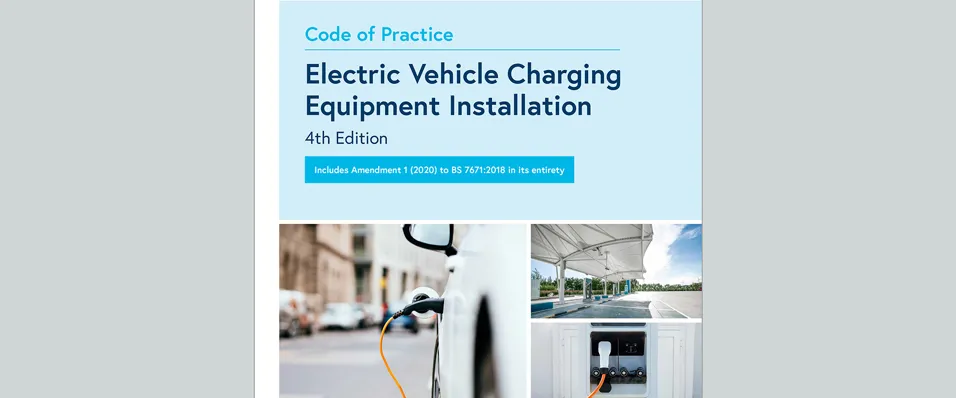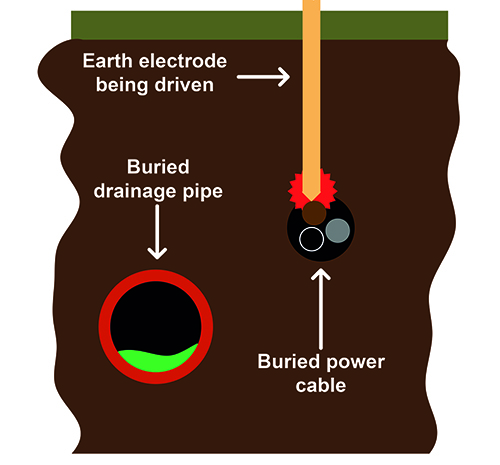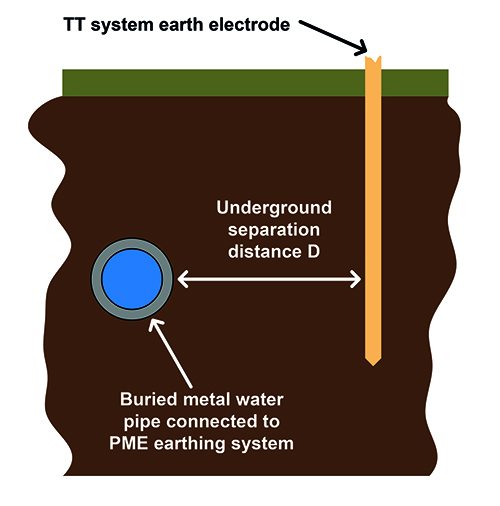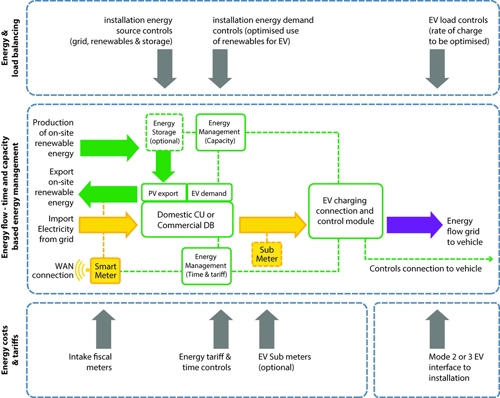
The IET Code of Practice for Electric Vehicle Charging Equipment Installation, 4th Edition
Introduction
There is a rapid pace of development in the electric vehicle (EV) sector. In addition to addressing Amendment 1 (2020) to BS 7671:2018 + A1:2020, the publication contains several important and informative updates, including:
- guidance on the selection and use of open-circuit protective earth and neutral (open PEN) detection devices for use in installations in which protective multiple earthing (PME) conditions apply
- guidance for on-street installations (updated to cover a wide range of situations)
- a new approach to determining load unbalance in three-phase installations
- guidance on the dangers associated with so-called ‘TT islands’, and safe separation distances below ground for TT earth electrodes from buried metalwork connected to other earthing systems, and
- extended guidance on smart integration and vehicle-to-grid.
This article provides some insight into these updates.
The Issue 79 - March 2020 Wiring Matters article by Geoff Cronshaw provides an overview of the changes introduced in Amendment 1 (2020).
Emerging issues with ‘TT islands’
Since the publication of BS 7671:2018 Requirements for Electrical Installations (IET Wiring Regulations, 18th Edition), installers have increasingly adopted a TT earthing arrangement to comply with Regulation 722.411.4.1 of BS 7671. The installation practices for this approach have not always achieved an improvement in safety. The principal safety issues encountered when installing this type of system for charging points are:
(a) simultaneous contact between exposed-conductive-parts, such as the vehicle on charge (connected to the TT earthing system) and exposed metalwork connected to the PME earthing system, for example, building cladding, or exposed-conductive-parts of other outdoor equipment. Extensive guidance for this was included in previous editions of the IET Code of Practice for Electric Vehicle Charging Equipment Installation.
(b) risk of striking buried services when installing earth electrodes (Figure 1), especially when driving earth rods. It is not always possible to detect all such buried services and the alternative is excavation.
Figure 1: Risk of striking buried services when driving rods

(Image courtesy of G. Kenyon Technology Ltd)
(c) separation below ground between the TT earth electrode and buried metalwork connected to the PME earthing system (Figure 2). If the separation is not great enough, the EV charging equipment is effectively connected to the PME earthing system and no protection is offered.
Figure 2: Separation from buried metalwork connected to PME earthing system

(Image courtesy of G. Kenyon Technology Ltd)
(d) return of touch potential: this may be caused by buried conductive parts connected to the PME earthing system affecting the potential of ground on which a person who may come into contact with the vehicle on charge is standing (Figure 3).
Figure 3: Possible return of touch potential in some conditions because of electrode separation and coincidentally located buried conductive parts connected to a PME earthing system

(Image courtesy of G. Kenyon Technology Ltd)
New guidance is included on these topics in Annex H to the Code of Practice. Table H1 provides recommended separation distances below ground for earth electrodes, although installers should be aware that some distribution network operators (DNOs) may require a greater separation distance.
Installers may have difficulty in establishing precisely what is buried in the vicinity of the intended earth electrode location. In certain situations, particularly smaller curtilage properties such as typical residential housing, addressing all of these constraints may not be practicable. Note 6 to Regulation 722.411.4.1 in Amendment No. 1 (2020) highlights this.
It is clear that different approaches are required, and the 4th edition of the IET Code of Practice has some guidance on alternatives.
Open PEN detection devices
One solution to the issues with separate TT earthing systems for EV charging equipment is the use of open PEN detection devices. These devices are relatively new and at present, there are no product-specific standards. The 4th edition provides the guidance that installers need to select and install these new protective devices, in Section 5.3.5.
Regulation 722.411.4.1 (iii), (iv) and (v) of BS 7671 relate to the different technologies currently available for such devices.
Open PEN detection devices of the type described in Regulation 722.411.4.1 (iv) rely on a measurement of the line to neutral utilization voltage at the charging point. These devices are only suitable for installations with single-phase supplies and should not be used for single-phase charging equipment in a three-phase installation.
Open PEN detection devices that achieve the requirements of Regulation 722.411.4.1 (iii) currently adopt two approaches:
- monitoring of the voltage between the protective conductor of the charging point and a measurement earth electrode. In a similar manner to TT earth electrodes, the measurement earth electrode should be separated from buried metalwork connected to the PME earthing terminal, or a voltage will not be detected. Guidance is provided in the new Annex I to the Code of Practice, which recommends a minimum separation distance, and voltage trip threshold, for open PEN detection devices that use a measurement earth electrode. This type of device may be used in either single-phase or three-phase installations.
- monitoring of the voltage between the protective conductor or neutral at the charging point and a measurement point derived from the phase conductors of a three-phase supply. This type of device is only suitable for use in three-phase installations, but may be used to protect single-phase charging points in a three-phase installation, provided the device is fitted upstream in a three-phase part of the installation that supplies the single-phase charging point. No earth electrode is required.
Open PEN detection devices that do not operate in precisely the manner described in Regulation 722.411.4.1 (iii) or (iv) also exist. They may be used, according to Regulation 722.411.4.1 (v), provided that they offer at least the same level of safety.
An important feature of the wording in Regulations 722.411.4.1 (iii) and (iv) is that the devices shall not be capable of re-closing onto the hazardous conditions they are intended to detect. In order to provide equivalent safety, a device described in Regulation 722.411.4.1 (v) must also have the same feature.
Some types of open PEN detection device may have limitations when used in a prosumer’s electrical installation that is operating in island mode.
New guidance on balanced three-phase systems
Regulation 722.411.4.1 (i) of BS 7671 permits the direct connection of EV charging equipment to the PME earthing terminal in installations where the loading on the phases will be sufficiently well-balanced to prevent the PME earthing terminal rising above 70 V rms during open-circuit PEN conductor conditions.
In previous editions of the IET Code of Practice for Electric Vehicle Charging Equipment Installation, this approach was considered to be of limited practical use. However, further research in this area has helped uncover the limiting unbalance conditions, and the amount of imbalance required may be quite surprising.
A new approach developed by the author is published in Annex J of the IET Code of Practice. Lengthy calculations using the formulas in A722.1 and A722.2 of BS 7671 are no longer necessary. Knowing only the load currents of each of the three phases for the worst-case unbalance conditions, designers and installers can choose to use either:
- a rule of thumb, as per Annex J, item J4 (Figure 4) or
- for a more accurate approach, a look-up table, Annex J, Table J1, that uses the ratios of the load currents of each of the two most lightly loaded phases to the load current of the most heavily loaded phase.
Figure 4: Rule of thumb relating to 722.411.4.1 (i)
(see J4, Annex J, to the IET Code of Practice for Electric Vehicle Charging Equipment Installation, 4th Edition)

Vehicle as storage guidance
Section 10 of the IET Code of Practice discusses vehicle as storage. The guidance has been enhanced to discuss the relationship envisaged between a vehicle as storage and the grid. The guidance now includes special considerations for vehicle-to-grid services and considers the vehicle as storage system as part of an integrated system with other microgeneration or local generation schemes.
Earthing arrangements for vehicle as storage connected to PME installations are also discussed.
Smart integration guidance
Another area of EV technology that is set to become key for future energy strategies is integration with the smart grid. Building on the foundation guidance in the 3rd edition of the IET Code of Practice, Section 12 in the 4th edition now includes information flow diagrams of different smart control and integration use cases, with extended commentaries, covering:
- managed charging
- demand-limited (load curtailment) charging
- smart meter integration and
- optimization for self-use of local renewable generation (Figure 5).
Figure 5: Integration representation: optimization for self-use of local renewable generation (updated for the IET by Cameron Steel)

Conclusion
The IET Code of Practice for Electric Vehicle Charging Equipment Installation, 4th Edition makes extensive improvements to the guidance to cover new protection and control technologies that have emerged since the publication of the previous edition, in addition to supporting the latest installation safety requirements in BS 7671:2018+A1:2020.
The Code of Practice is available now from the IET Bookshop.
